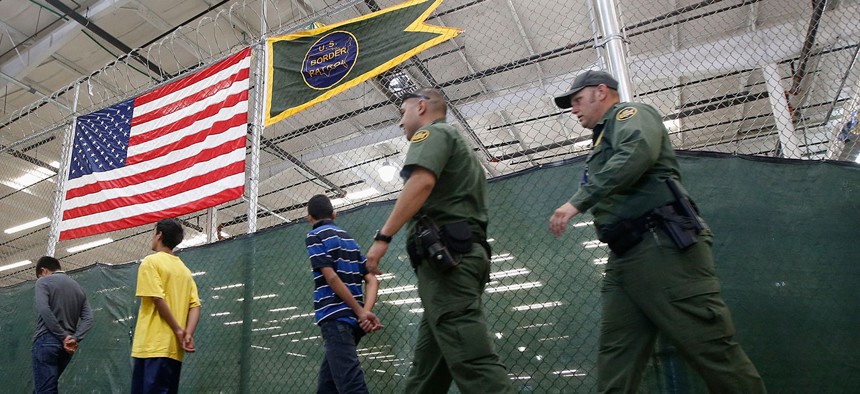
Young detainees are being escorted to an area to make phone calls as hundreds of mostly Central American immigrant children are being processed and held at the U.S. Customs and Border Protection Nogales Placement Center in Nogales, Ariz., in 2014. Ross D. Franklin/AP file photo
Trump Can Hold Immigrant Kids In Military Facilities — If He Turns Them Into Shelters
Any spaces used to detain children must meet a long list of criteria in order to comply with U.S. laws.
The Trump administration is reportedly looking into holding undocumented immigrant children in military facilities.
That’s because the number of unaccompanied minors illegally in the U.S., which the federal government is required to house, is set to grow. The Department of Homeland Security is rolling out a mandate to prosecute everyone caught entering the U.S. without permission, which is a crime under federal law. That policy will likely result in the separation of children from their parents during the time it takes for the adults’ legal cases to go through the court system.
So suddenly, the administration finds itself in need of more beds for those “unaccompanied minors,” who are entitled to special treatment while in federal custody. The government has to follow a specific set of guidelines established by the 1997 settlement of a 1985 lawsuit called Flores v. Reno. It was filed by immigrant advocates questioning the government’s treatment of immigrant children. Over the years, the government has been sued numerous times for failing to fulfill that settlement, and has passed additional laws to add further requirements.
Immigrant advocates have condemned any plan that sees unaccompanied minors housed in military facilities. Though the standards don’t overtly bar the government from doing that. Still, if the Trump administration decides to go ahead with the plan that the Washington Post and others have reported it is considering, it will have to meet the standards—of face another lawsuit. Here’s what it would have to do to achieve that:
Transfer within 72 hours
In 2002, the Homeland Security Act was passed. It said that immigrant children deemed to be unaccompanied by adults have to be transferred to the Office of Refugee Resettlement within 72 hours of being apprehended by Homeland Security.
Release to parent or guardian
The Flores settlement states that federal authorities must release the detained children to a parent or guardian whenever possible. They must also provide help locating relatives or other potential caretakers within and outside the U.S.
Legal services
The children should also be informed of available free legal services, and of their rights, including that of having an immigration court hearing.
Safe, sanitary, and “least-restrictive” possible environment
Under the settlement, the Department of Homeland Security must also place children in “the least restrictive setting appropriate to the minor’s age and special needs.” That often means state-licensed shelters for children, which must meet a long set of criteria laid out in the Flores settlement.
Aside from being “safe and sanitary,” the facilities must, for example, provide routine medical and dental care, as well as education in a structured classroom setting. That should include English language training, as well as the provision of reading materials in the detained children’s native languages. The centers should also offer kids counseling, and a “a reasonable right to privacy” to talk on the phone and store their belongings.
Recreation
While in the custody of the Office of Refugee Resettlement, the immigrant children should also be given time to play outside: at least one hour a day of “large muscle activity,” and another hour for “structured leisure time activities.” Watching TV doesn’t count.
NEXT STORY: Pompeo Declares Economic War on Iran






